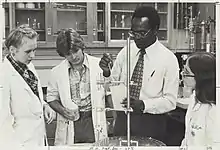Christopher J Chetsanga | |
|---|---|
 Christopher Chetsanga demonstrates to students how to do an experiment | |
| Born | 22 August 1935 |
| Nationality | Zimbabwean |
| Alma mater | University of California Pepperdine University University of Toronto |
| Known for | Discovery of two enzymes involved in DNA repair Academic administration |
| Scientific career | |
| Fields | Biochemistry Molecular Biology |
| Institutions | Harvard University University of Michigan University of Zimbabwe Scientific and Industrial Research and Development Centre Zimbabwe Ezekiel Guti University |
Christopher J. Chetsanga (born 1935 in Murehwa, Rhodesia) is a prominent Zimbabwean scientist who is a member of the African Academy of Sciences and The World Academy of Sciences.[1][2] He discovered two enzymes involved in DNA repair.[3][4] He has also held various academic administrative posts like Vice-Chancellor, Director and Dean.
Biography
Chetsanga was born in Murewa, Zimbabwe on 22 August 1935,[5] and was baptised in 1948. In his youth, he was educated at Nhowe Mission, and went on to study at University of California, Berkeley where he received his BSc in 1965. Chetsanga also studied for a period at Pepperdine University.[6] In 1969, he received his MSc and PhD in biochemistry and molecular biology from University of Toronto[6] before becoming a post doctoral fellow at Harvard University between 1969 and 1972.[5] Between 1972 and 1983 he became a professor at the University of Michigan, then in 1983 he left to become the senior lecturer in Biochemistry for University of Zimbabwe.[7] In 1990, President Robert Mugabe awarded him President’s Award for Distinguished Contribution to Science and Technology.[5][8][9] Has also awarded the Order of the Star of Zimbabwe.[10] He is presently the vice chancellor at Zimbabwe Ezekiel Guti University.[11]
In 2004, when the Zimbabwe Academy of Sciences was formed, Chetsanga was appointed the first president of the academy.[12] Chetsanga advocated the use of genetically modified food sources as a possible solution for food shortages in Africa in 2020.[13]
Scientific Achievements
Chetsanga has discovered two enzymes involved in the repair of damaged DNA: firstly, formamidopyrimidine DNA glycosylase, which removes damaged 7-methylguanine from DNA (1979),[4] and secondly, purine imidazole-ring cyclase, which re-closes imidazole rings of guanine and adenine damaged by x-irradiation (1985).[3]
According to Chetsanga, his research focus in his scientific career has been on DNA and RNA structural and functional details as they relate to cellular metabolism and disease development.[14]
Select publications
- C. J. Chetsanga; V. Boyd; L. Peterson; K. Rushlow (1 January 1975). "Single-stranded regions in DNA of old mice" (PDF). Nature. 253 (5487): 130–131. doi:10.1038/253130A0. ISSN 1476-4687. PMID 1110761. Wikidata Q59071826.
- C. J. Chetsanga; Tomas Lindahl (10 August 1979). "Release of 7-methylguanine residues whose imidazole rings have been opened from damaged DNA by a DNA glycosylase from Escherichia coli". Nucleic Acids Research. 6 (11): 3673–84. doi:10.1093/NAR/6.11.3673. ISSN 0305-1048. PMC 327965. PMID 386277. Wikidata Q24632415.
- C J Chetsanga; C Grigorian (February 1985). "In situ enzymatic reclosure of opened imidazole rings of purines in DNA damaged by gamma-irradiation". Proceedings of the National Academy of Sciences of the United States of America. 82 (3): 633–7. Bibcode:1985PNAS...82..633C. doi:10.1073/PNAS.82.3.633. ISSN 0027-8424. PMC 397099. PMID 3856219. Wikidata Q24568209.
References
- ↑ AAS. "Chetsanga, J. Christophe, Prof." Archived 2014-09-03 at the Wayback Machine, Fellow of AAS since 1986; Biochemistry and Molecular Biology, Nairobi, unknown. Retrieved on 28 August 2014.
- ↑ "Christopher Chetsanga - Pepperdine's Outstanding Alumni Abroad | Pepperdine University". www.pepperdine.edu. Retrieved 2022-10-03.
- 1 2 Chetsanga, C.J.; Grigorian, C. (1985). "In situ enzymatic reclosure of opened imidazole rings of purines in DNA damaged by gamma-irradiation". Proceedings of the National Academy of Sciences of the United States of America. 82 (3): 633–637. Bibcode:1985PNAS...82..633C. doi:10.1073/pnas.82.3.633. JSTOR 25324. PMC 397099. PMID 3856219.
- 1 2 Chetsanga, C.J.; Lindahl, T. (1979). "Release of 7-methylguanine residues whose imidazole rings have been opened from damaged DNA by a DNA glycosylase from Escherichia coli". Nucleic Acids Res. 6 (11): 3673–84. doi:10.1093/nar/6.11.3673. PMC 327965. PMID 386277.
- 1 2 3 "CHETSANGA Christopher J." TWAS. The World Academy of Science. Retrieved 19 July 2020.
- 1 2 David Mubvumbi, Paradzayi (2016). Christianity And Traditional Religions Of Zimbabwe : Contrasts And Similarities. Westbow Press. ISBN 9781512745108. Retrieved 19 July 2020.
- ↑ "Prof. Christopher James Chetsanga". University of Zimbabwe. Retrieved 19 July 2020.
- ↑ "EAI International Conference for Research, Innovation and Development for Africa". EAI. June 2017. Retrieved 19 July 2020.
- ↑ "Chetsanga Christopher". African Academy of Sciences. Retrieved 19 July 2020.
- ↑ Ziana, New (2021-08-09). "Zimbabwe awards civilian heroes - New Ziana". Retrieved 2022-10-03.
- ↑ "Zimbabwe Ezekiel Guti University - Home". www.zegu.ac.zw. Retrieved 2021-06-02.
- ↑ "OWSD Zimbabwe National Chapter is Launched". Organization for women in science for the developing world. 20 November 2018. Retrieved 19 July 2020.
- ↑ "GMB to import GMO Maize". NewsdzeZimbabwe. 23 April 2020. Retrieved 19 July 2020.
- ↑ "Christopher J. Chetsanga". Pepperdine. Retrieved 19 July 2020.